Development of an Irrigation Method with a Cycle of Wilting–Partial Recovery Using an Image-Based Irrigation System for High-Quality Tomato Production
Abstract
1. Introduction
2. Materials and Methods
2.1. Greenhouse and Plant Materials
2.2. Treatments
2.3. Measured Parameters
2.3.1. Greenhouse Environment
2.3.2. Cumulative Wilting Ratio
2.3.3. Plant Growth
2.3.4. Yield and Fruit Quality
2.3.5. Cumulative Air Temperature from Anthesis to Fruits Harvest
2.4. Statistical Analysis
3. Results
3.1. Environmental Conditions
3.2. Transition of Wilting Ratio
3.3. Irrigation Amount and Frequency
3.4. Plant Growth
3.5. Yield
3.6. Fruit Quality
4. Discussion
4.1. Irrigation Management Using the Image-Based Irrigation System
4.2. Plant Growth
4.3. Yield
4.4. Fruit Quality
5. Conclusions
Author Contributions
Funding
Institutional Review Board Statement
Informed Consent Statement
Data Availability Statement
Acknowledgments
Conflicts of Interest
References
- Nuruddin, M.M.; Madramootoo, C.A.; Dodds, G.T. Effects of water stress at different growth stages on greenhouse tomato yield and quality. HortScience 2003, 38, 1389–1393. [Google Scholar] [CrossRef]
- Liu, H.; Li, H.H.; Ning, H.F.; Zhang, X.X.; Li, S.; Pang, J.; Wang, G.S.; Sun, J.S. Optimizing irrigation frequency and amount to balance yield, fruit quality and water use efficiency of greenhouse tomato. Agric. Water Manag. 2019, 226, 105787. [Google Scholar] [CrossRef]
- Machado, R.M.A.; Oliveira, M.D.R.G. Tomato root distribution, yield and fruit quality under different subsurface drip irrigation regimes and depths. Irrig. Sci. 2005, 24, 15–24. [Google Scholar] [CrossRef]
- Rao, N.K.S.; Bhatt, R.M.; Sadashiva, A.T. Tolerance to water stress in tomato cultivars. Photosynthetica 2000, 38, 465–467. [Google Scholar] [CrossRef]
- Yuan, X.K.; Yang, Z.Q.; Li, Y.X.; Liu, Q.; Han, W. Effects of different levels of water stress on leaf photosynthetic characteristics and antioxidant enzyme activities of greenhouse tomato. Photosynthetica 2016, 54, 28–39. [Google Scholar] [CrossRef]
- Chand, J.; Hewa, G.; Hassanli, A.; Myers, B. Evaluation of deficit irrigation and water quality on production and water productivity of tomato in greenhouse. Agriculture 2020, 10, 297. [Google Scholar] [CrossRef]
- Nangare, D.D.; Singh, Y.; Kumar, P.S.; Minhas, P.S. Growth, fruit yield and quality of tomato (Lycopersicon esculentum Mill.) as affected by deficit irrigation regulated on phenological basis. Agric. Water Manag. 2016, 171, 73–79. [Google Scholar] [CrossRef]
- Badr, M.A.; El-Tohamy, W.A.; Abou-Hussein, S.D.; Gruda, N. Tomato yield, physiological response, water and nitrogen use efficiency under deficit and partial root zone drying irrigation in an arid region. J. Appl. Bot. Food Qual. 2018, 91, 332–340. [Google Scholar] [CrossRef]
- Nakahara, M.; Inoue, Y. Detecting water stress in differentially-irrigated tomato plants with infrared thermometry for cultivation of high-Brix fruits. J. Agric. Meteorol. 1997, 53, 191–199, (In Japanese with English abstract). [Google Scholar] [CrossRef]
- Oishi, N. Development of irrigation control system in response to plant water stress in tomato hydroponics (1)—Non-destructive evaluation of plant water stress by the change of stem diameter. Environ. Control. Biol. 2002, 40, 81–89, (In Japanese with English abstract). [Google Scholar] [CrossRef][Green Version]
- Oishi, N.; Imahara, J.; Kani, H. Development of fertigation control system based on measuring plant weight using load cell for high-Brix tomato hydroponics. J. SHTA 2018, 30, 94–102, (In Japanese with English abstract). [Google Scholar] [CrossRef]
- Takayama, K.; Nishina, H. Early detection of water stress in tomato plants based on projected plant area. Environ. Control. Biol. 2007, 45, 241–249. [Google Scholar] [CrossRef]
- Hikosaka, S.; Inoue, K.; Ishigami, Y.; Goto, E. Development of an automatic water-stress control system by image analysis for the production of high-quality tomato. Acta Hortic. 2019, 1296, 1027–1034. [Google Scholar] [CrossRef]
- Zhao, F.; Yoshida, H.; Goto, E.; Hikosaka, S. Development of an automatic irrigation method using an image-based irrigation system for high-quality tomato production. Agronomy 2022, 12, 106. [Google Scholar] [CrossRef]
- Saha, R.R.; Hara, M.H. Influence of different soil moisture regimes on biomass production, water use, and nitrogen nutrition of tomato plants. Environ. Control. Biol. 1998, 36, 1–12. [Google Scholar] [CrossRef]
- Kiani, S.P.; Talia, P.; Maury, P.; Grieu, P.; Heinz, R.; Perrault, A.; Nishinakamasu, V.; Hopp, E.; Gentzbittel, L.; Paniego, N.; et al. Genetic analysis of plant water status and osmotic adjustment in recombinant inbred lines of sunflower under two water treatments. Plant Sci. 2007, 172, 773–787. [Google Scholar] [CrossRef]
- Liu, H.; Duan, A.W.; LI, F.S.; Sun, J.S.; Wang, Y.C.; Sun, C.T. Drip irrigation scheduling for tomato grown in solar greenhouse based on pan evaporation in North China Plain. J. Integr. Agric. 2013, 12, 520–531. [Google Scholar] [CrossRef]
- Harmanto; Salokhe, V.M.; Babel, M.S.; Tantau, H.J. Water requirement of drip irrigated tomatoes grown in greenhouse in tropical environment. Agric. Water Manag. 2005, 71, 225–242. [Google Scholar] [CrossRef]
- Mitchell, J.P.; Shennan, C.; Grattan, S.R.; May, D.M. Tomato fruit yields and quality under water deficit and salinity. J. Am. Soc. Hortic. Sci. 1991, 116, 215–221. [Google Scholar] [CrossRef]
- Sato, S.; Peet, M.M.; Thomas, J.F. Physiological factors limit fruit set of tomato (Lycopersicon esculentum Mill.) under chronic, mild heat stress. Plant Cell Environ. 2000, 23, 719–726. [Google Scholar] [CrossRef]
- Ruiz-Nieves, J.M.; Ayala-Garay, O.J.; Serra, V.; Dumont, D.; Vercambre, G.; Génard, M.; Gautier, H. The effects of diurnal temperature rise on tomato fruit quality. Can the management of the greenhouse climate mitigate such effects? Sci. Hortic. 2021, 278, 109836. [Google Scholar] [CrossRef]
- Guichard, S.; Bertin, N.; Leonardi, C.; Gary, C. Tomato fruit quality in relation to water and carbon fluxes. Agronomie 2001, 21, 385–392. [Google Scholar] [CrossRef]
- Kubota, C.; Kroggel, M.; Torabi, M.; Dietrich, K.A.; Kim, H.J.; Fonseca, J.; Thomson, C.A. Changes in selected quality attributes of greenhouse tomato fruit as affected by pre- and postharvest environmental conditions in year-round production. HortScience 2012, 47, 1698–1704. [Google Scholar] [CrossRef]
- Hussey, G. Growth and development in the young tomato: III. The effect of night and day temperatures on vegetative growth. J. Exp. Bot. 1965, 16, 373–385. [Google Scholar] [CrossRef]
- Lu, T.; Meng, Z.J.; Zhang, G.X.; Qi, M.F.; Sun, Z.P.; Liu, Y.F.; Li, T.L. Sub-high temperature and high light intensity induced irreversible inhibition on photosynthesis system of tomato plant (Solanum lycopersicum L.). Front. Plant Sci. 2017, 8, 365. [Google Scholar] [CrossRef] [PubMed]
- Leonardi, C.; Guichard, S.; Bertin, N. High vapour pressure deficit influences growth, transpiration and quality of tomato fruits. Sci. Hortic. 2000, 84, 285–296. [Google Scholar] [CrossRef]
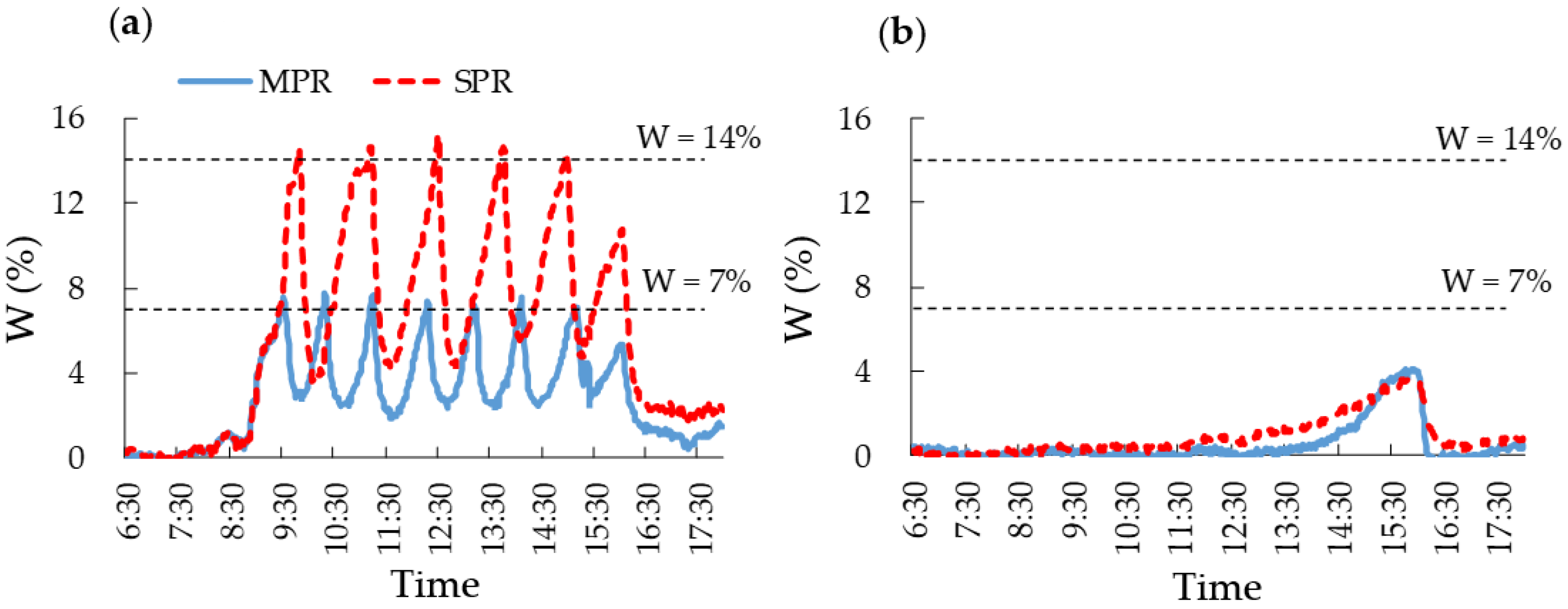
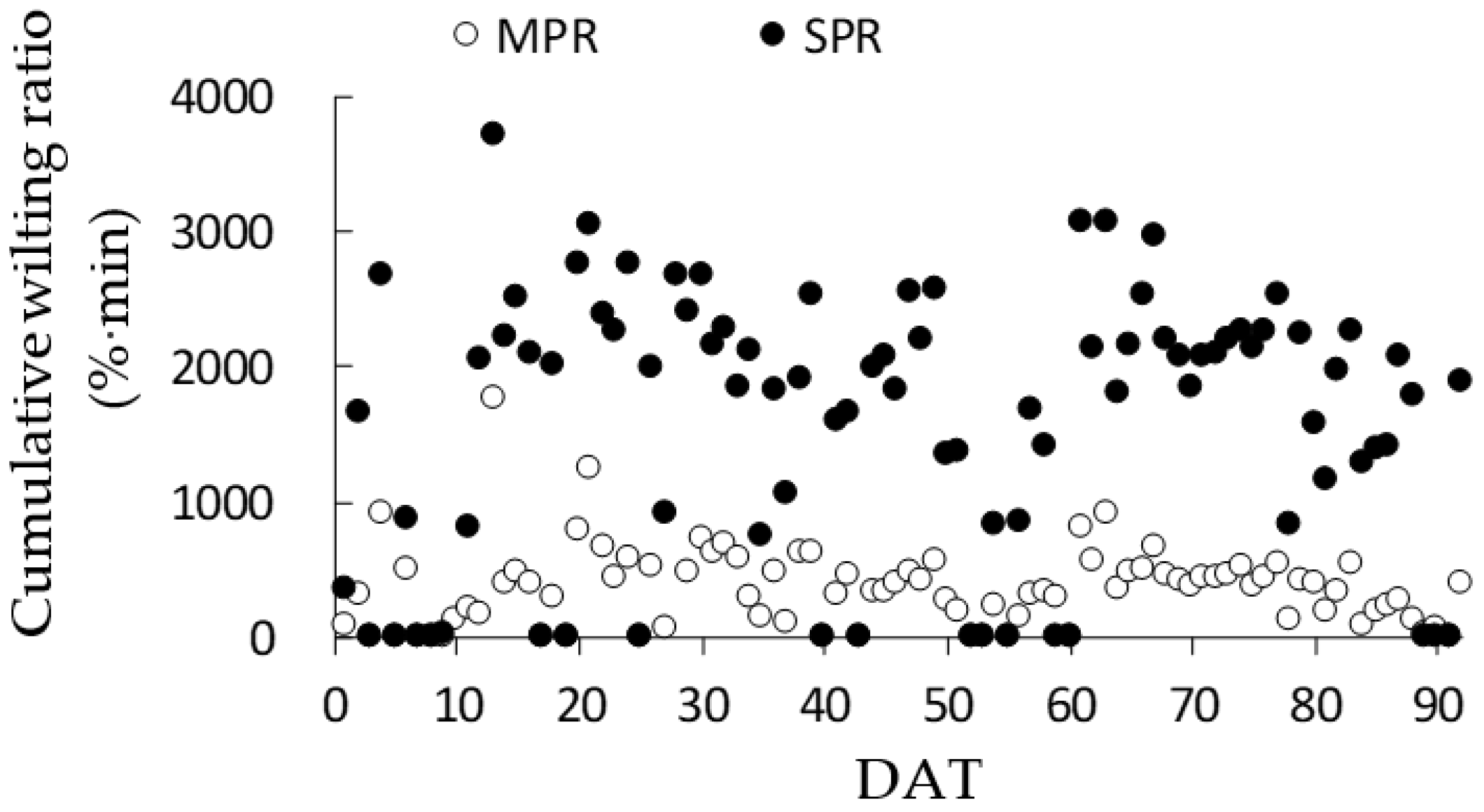
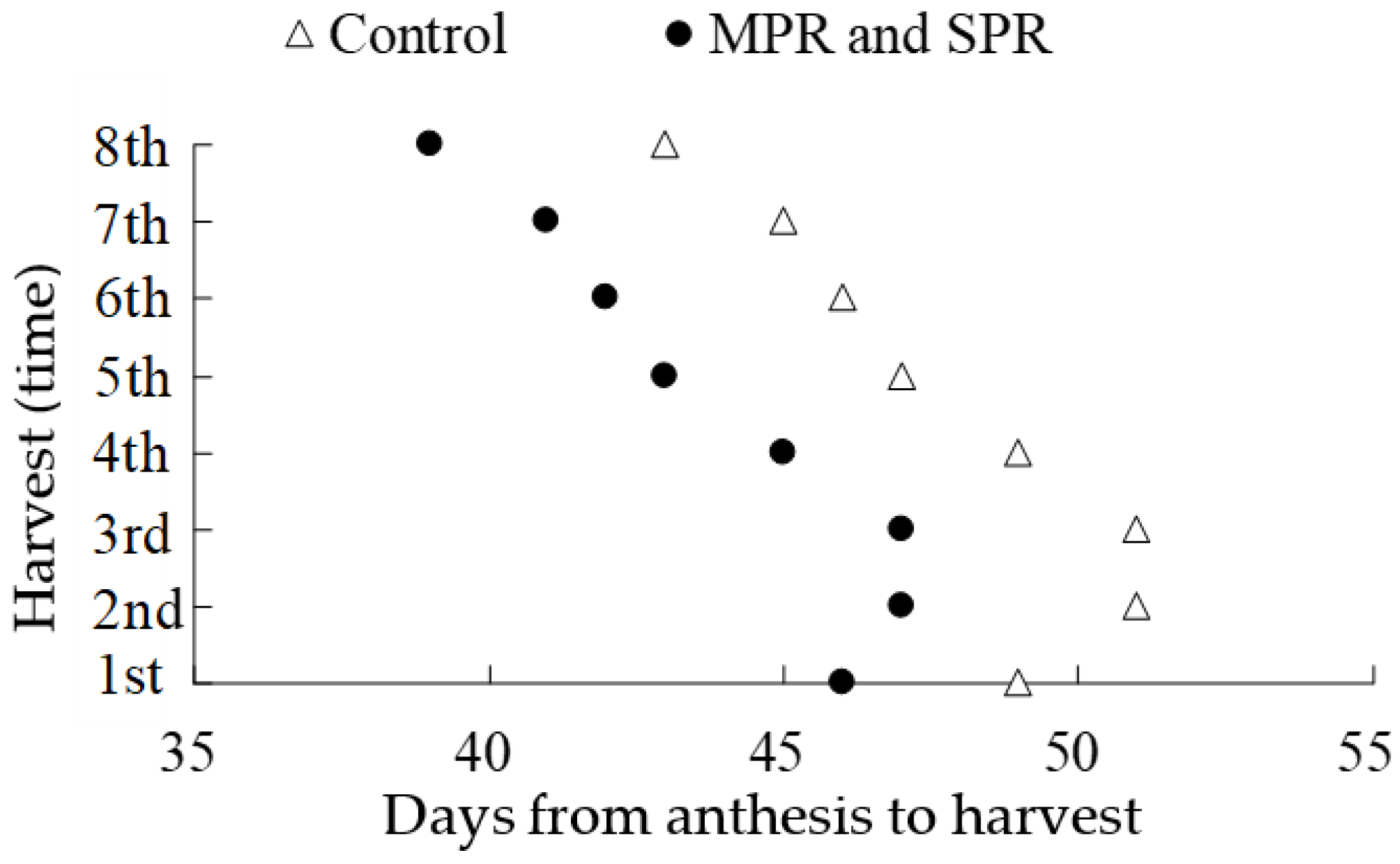
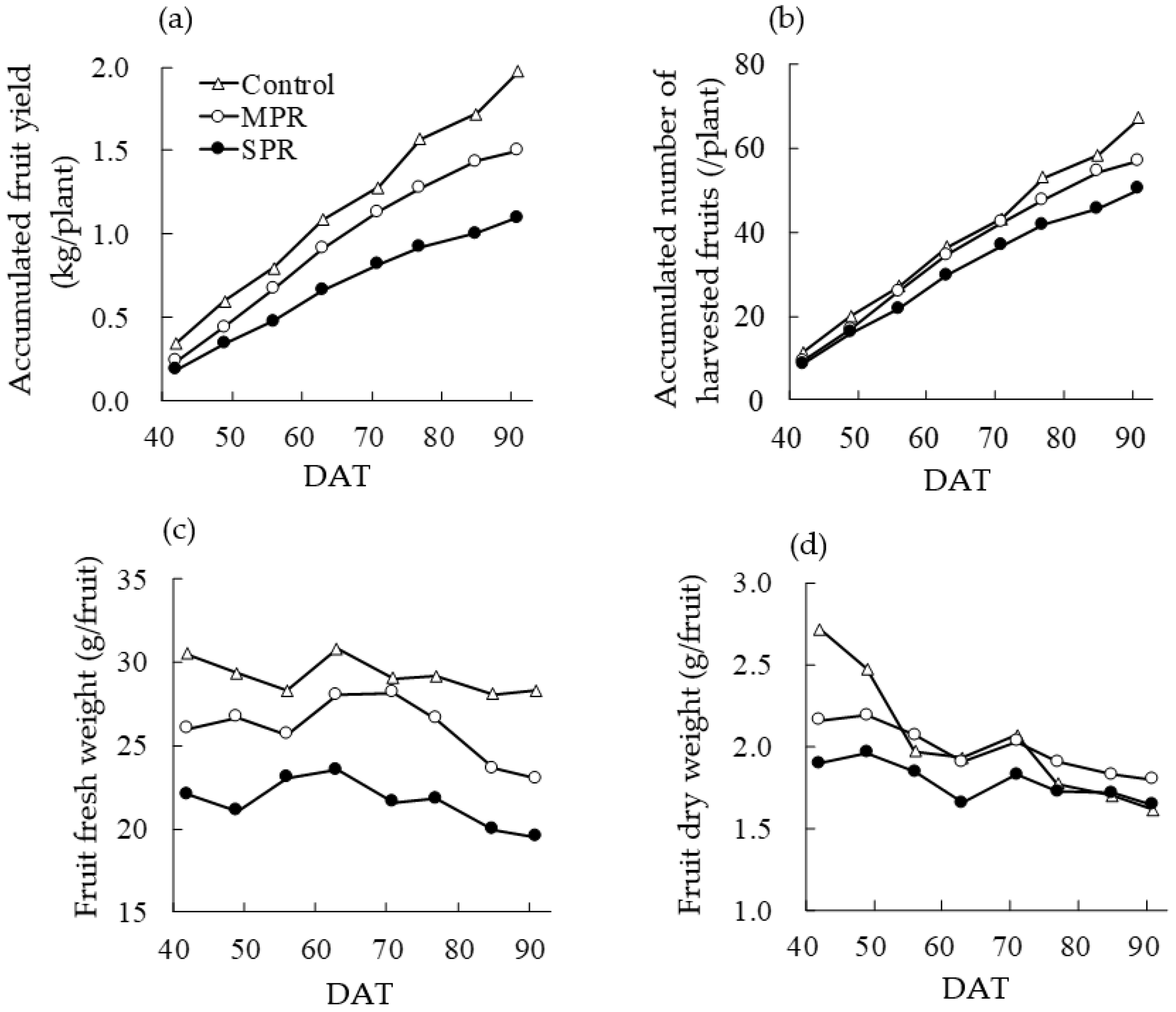
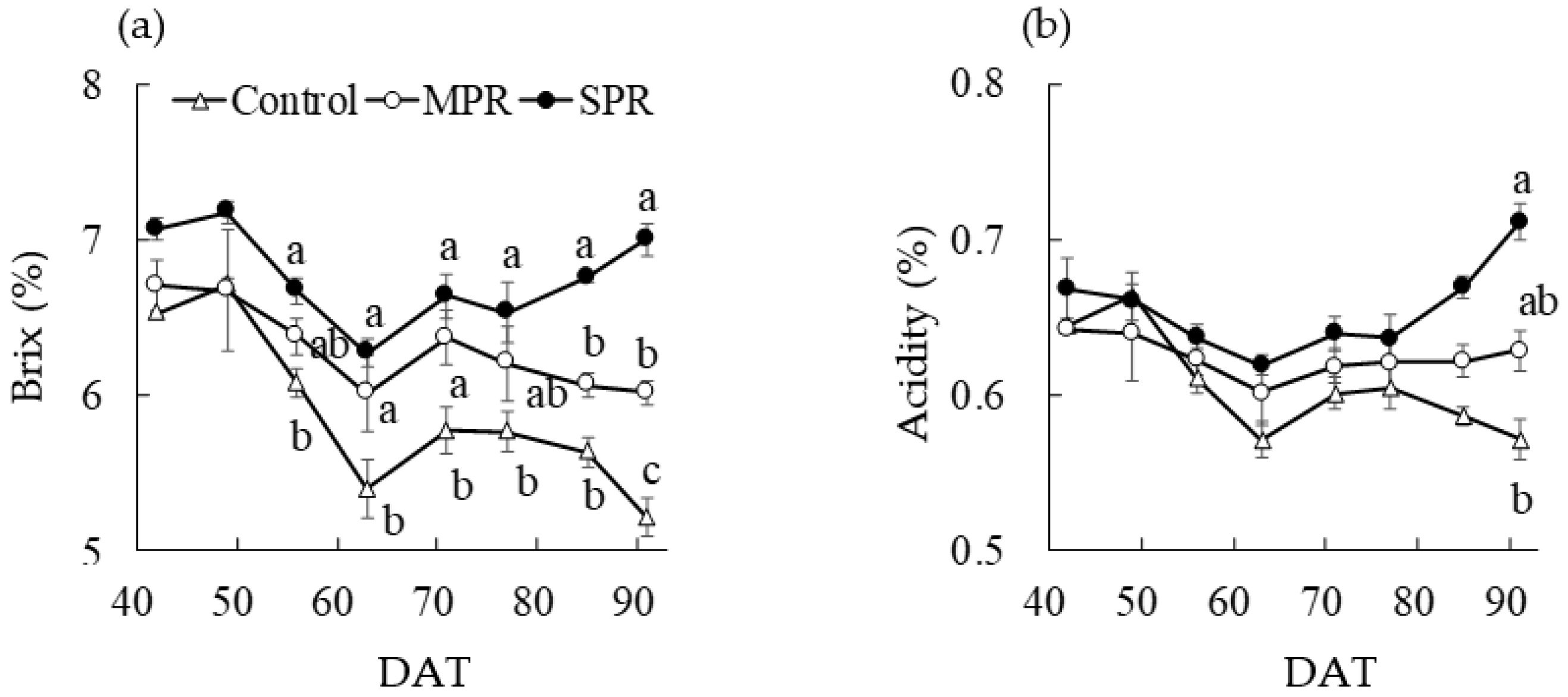
| Environmental Factors | 1–42 DAT | 43–60 DAT | 61–92 DAT |
|---|---|---|---|
| Daily Light Integral (DLI) (mol m–2 day–1) | 25.1 | 15.9 | 30.6 |
| Air Temperature (daytime/nighttime) (°C) | 24.6/19.9 | 24.7/21.9 | 30.1/25.7 |
| Vapor Pressure Deficit (VPD) (daytime/nighttime) (kPa) | 1.1/0.4 | 0.8/0.4 | 1.4/0.6 |
| Treatment (DAT) | Daily Irrigation Amount (L/Plant) /Irrigation Frequency (Times) | Irrigation Amount (L/Plant)/Irrigation Frequency (Times) | ||
|---|---|---|---|---|
| (1–42) | (43–60) | (61–92) | Total (1–92) | |
| Control | 1.20/40 | 1.20/40 | 1.20/40 | 110/3680 (100/100) y |
| MPR | 0.96/6.2 | 0.53/4.2 | 1.04/9.1 | 83/628 (75/17) |
| SPR | 0.78/5.4 | 0.40/2.7 | 0.76/4.6 | 65/424 (59/12) |
| Treatment | Plant Length (m) | Stem Diameter (mm) | Leaf Area (m2/Plant) | Number of Leaves (/Plant) | Fresh Weight (kg/Plant) | Dry Weight (g/Plant) | Dry Matter Ratio (%) |
|---|---|---|---|---|---|---|---|
| Control | 5.0 ± 0.1 a z (100) y | 12.2 ± 0.3 a (100) | 0.27 ± 0.02 a (100) | 61 ± 1 a (100) | 1.32 ± 0.14 a (100) | 147 ± 15 a (100) | 11.13 ± 0.08 b (100) |
| MPR | 4.3 ± 0.1 b (85) | 10.4 ± 0.4 b (85) | 0.20 ± 0.01 ab (75) | 56 ± 1 b (92) | 0.90 ± 0.07 b (68) | 129 ± 8 b (88) | 14.35 ± 0.18 a (129) |
| SPR | 3.9 ± 0.1 c (78) | 10.3 ± 0.2 b (84) | 0.17 ± 0.01 b (64) | 52 ± 0 c (86) | 0.89 ± 0.03 b (67) | 127 ± 4 b (87) | 14.37 ± 0.18 a (129) |
Publisher’s Note: MDPI stays neutral with regard to jurisdictional claims in published maps and institutional affiliations. |
© 2022 by the authors. Licensee MDPI, Basel, Switzerland. This article is an open access article distributed under the terms and conditions of the Creative Commons Attribution (CC BY) license (https://creativecommons.org/licenses/by/4.0/).
Share and Cite
Zhao, F.; Yoshida, H.; Goto, E.; Hikosaka, S. Development of an Irrigation Method with a Cycle of Wilting–Partial Recovery Using an Image-Based Irrigation System for High-Quality Tomato Production. Agronomy 2022, 12, 1410. https://doi.org/10.3390/agronomy12061410
Zhao F, Yoshida H, Goto E, Hikosaka S. Development of an Irrigation Method with a Cycle of Wilting–Partial Recovery Using an Image-Based Irrigation System for High-Quality Tomato Production. Agronomy. 2022; 12(6):1410. https://doi.org/10.3390/agronomy12061410
Chicago/Turabian StyleZhao, Fei, Hideo Yoshida, Eiji Goto, and Shoko Hikosaka. 2022. "Development of an Irrigation Method with a Cycle of Wilting–Partial Recovery Using an Image-Based Irrigation System for High-Quality Tomato Production" Agronomy 12, no. 6: 1410. https://doi.org/10.3390/agronomy12061410
APA StyleZhao, F., Yoshida, H., Goto, E., & Hikosaka, S. (2022). Development of an Irrigation Method with a Cycle of Wilting–Partial Recovery Using an Image-Based Irrigation System for High-Quality Tomato Production. Agronomy, 12(6), 1410. https://doi.org/10.3390/agronomy12061410







